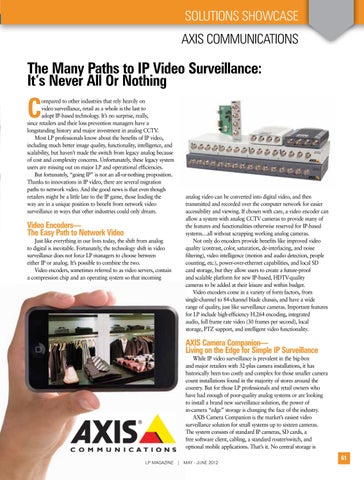Solutions Showcase Axis Communications
The Many Paths to IP Video Surveillance: It’s Never All Or Nothing
C
ompared to other industries that rely heavily on video surveillance, retail as a whole is the last to adopt IP-based technology. It’s no surprise, really, since retailers and their loss prevention managers have a longstanding history and major investment in analog CCTV. Most LP professionals know about the benefits of IP video, including much better image quality, functionality, intelligence, and scalability, but haven’t made the switch from legacy analog because of cost and complexity concerns. Unfortunately, these legacy system users are missing out on major LP and operational efficiencies. But fortunately, “going IP” is not an all-or-nothing proposition. Thanks to innovations in IP video, there are several migration paths to network video. And the good news is that even though retailers might be a little late to the IP game, those leading the way are in a unique position to benefit from network video surveillance in ways that other industries could only dream.
Video Encoders— The Easy Path to Network Video
Just like everything in our lives today, the shift from analog to digital is inevitable. Fortunately, the technology shift in video surveillance does not force LP managers to choose between either IP or analog. It’s possible to combine the two. Video encoders, sometimes referred to as video servers, contain a compression chip and an operating system so that incoming
analog video can be converted into digital video, and then transmitted and recorded over the computer network for easier accessibility and viewing. If chosen with care, a video encoder can allow a system with analog CCTV cameras to provide many of the features and functionalities otherwise reserved for IP-based systems…all without scrapping working analog cameras. Not only do encoders provide benefits like improved video quality (contrast, color, saturation, de-interlacing, and noise filtering), video intelligence (motion and audio detection, people counting, etc.), power-over-ethernet capabilities, and local SD card storage, but they allow users to create a future-proof and scalable platform for new IP-based, HDTV-quality cameras to be added at their leisure and within budget. Video encoders come in a variety of form factors, from single-channel to 84-channel blade chassis, and have a wide range of quality, just like surveillance cameras. Important features for LP include high-efficiency H.264 encoding, integrated audio, full frame rate video (30 frames per second), local storage, PTZ support, and intelligent video functionality.
AXIS Camera Companion— Living on the Edge for Simple IP Surveillance
While IP video surveillance is prevalent in the big-box and major retailers with 32-plus camera installations, it has historically been too costly and complex for those smaller camera count installations found in the majority of stores around the country. But for those LP professionals and retail owners who have had enough of poor-quality analog systems or are looking to install a brand new surveillance solution, the power of in-camera “edge” storage is changing the face of the industry. AXIS Camera Companion is the market’s easiest video surveillance solution for small systems up to sixteen cameras. The system consists of standard IP cameras, SD cards, a free software client, cabling, a standard router/switch, and optional mobile applications. That’s it. No central storage is LP Magazine | May - June 2012
61







